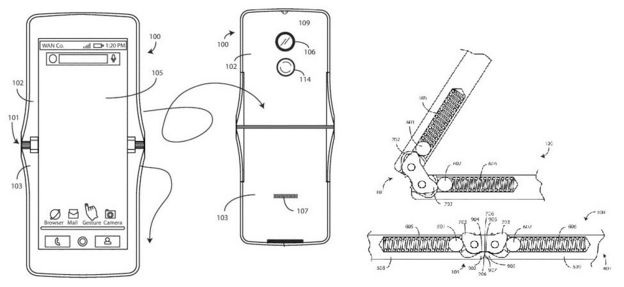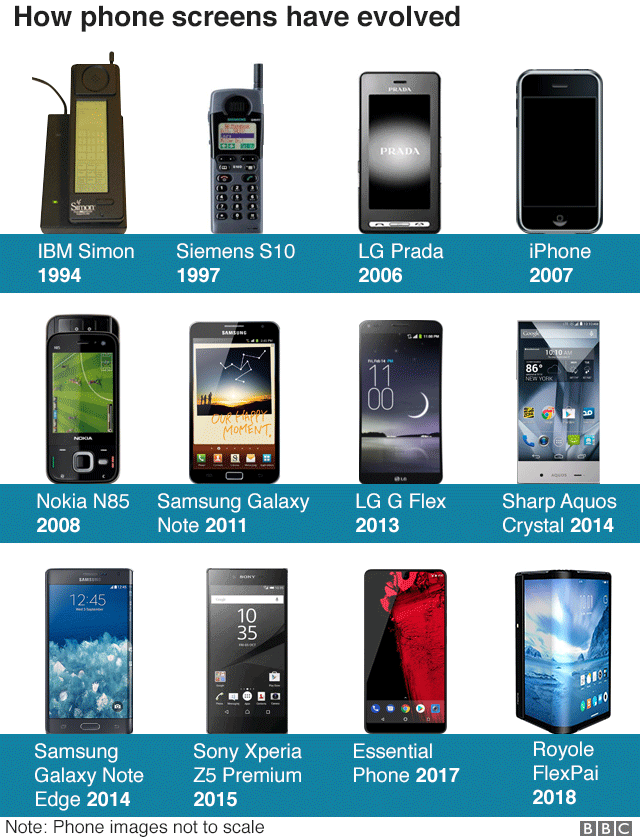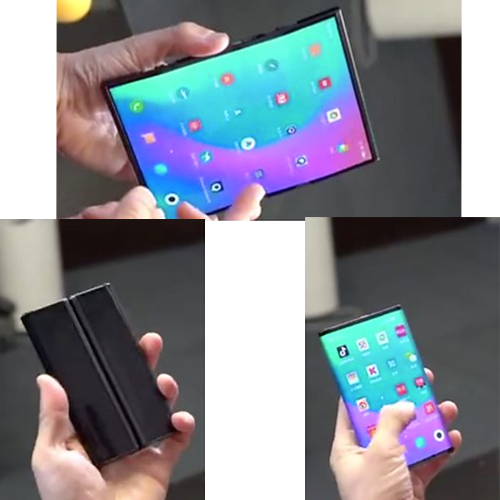A smartphone that transforms into a tablet by folding out two parts of its display bent behind its back has been unveiled by Xiaomi.
The Chinese technology company revealed the prototype in a post to the social media site Weibo. It promised the "double-folding" device was coming and asked the public to help name it.
Samsung and the start-up Royole have previously unveiled flexible-screened phones of their own.
But they only folded at a single point.
"It is very interesting that Xiaomi has adopted a three-way folding option on its prototype," said Ben Wood, from the consultancy CCS Insight.
"It is hard to judge the relative benefits of this versus a single fold and it will depend considerably on the user interface that Xiaomi chooses to adopt as it opens the ability to have a three-quarter screen option.
"However, it certainly means there is an additional point of failing. The fold is typically the area where there are most likely to be problems over time."
- Samsung folding smartphone revealed to developers
- Royole's bendy-screen FlexPai phone unveiled in China
- Huawei promises foldable phone within a year
Rumours of the device's existence began to circulate at the start of the month after the journalist Evan Blass posted a separate video of the handset to Twitter. However, he was unable to verify it was real.
The company has, however, confirmed to the BBC the latest clip, featuring its co-founder Bin Lin, is authentic, but said it had nothing to add at this point.
Weibo shows that the video has already been played nearly 3.5 million times and attracted thousands of comments since it was uploaded on Wednesday.
Foldable screens present smartphone-makers a means to make their products look more distinctive after a period during which they have coalesced around the same form: a dark black rectangle with ever-shrinking bezels.
But the innovation is expected to come at a steep price, at least when the first devices go on sale.
And it is unclear as yet what use cases manufacturers will promote to justify the added cost.
Royole is still seeking feedback from software creators via a "developers' version" of its handset. That went on sale late last year.
Huawei has said it will launch a phone with a fold-out screen in 2019, while Samsung has said it will reveal more details about its plans for the Galaxy X phone - first teased in November - at a press event on 20 February.
Lenovo-owned Motorola has also published a patent that illustrates how a flexible display could be incorporated into its classic flip-open Razr design.
And Google has said it is working on a new version of Android that will natively support "foldable" devices rather than requiring manufacturers to create their own workarounds to adapt to the changing dimensions of their devices' screens.
Other manufacturers may also have further announcements of their own to make at the Mobile World Congress trade show in Barcelona, which begins on 25 February.
"Folding displays are still very much a case of a solution looking for a problem but I remain firmly convinced that we are seeing the seeds being sown for the next generation of smart devices," said Mr Wood.
"[One concern is] the additional bulk the fold creates.
"However, there is no doubt a smartphone with a folding screen will be a magnet for gadget lovers."


IBM Simon: The first mobile phone to offer a touchscreen user-interface - but its battery only lasted an hour.
Siemens S10: The first handset with a colour display - although only red, green, blue and white could be shown.
LG Prada: The handset debuted a capacitive touchscreen - detecting finger taps by changes in the display's electrical field rather than pressure.
iPhone: Apple made use of "multi-touch", detecting several points of contact - allowing pinch-to-zoom and other interactions.
Nokia N85: First phone with an OLED (organic light-emitting diode) display, letting it show deeper blacks and better contrast.
Samsung Galaxy Note: Although not the first "phablet", the handset proved there was demand for a 5+ inch display, despite claims it was "comically huge".
LG G Flex: The curved design was derided as being a gimmick, but points the way to the true "bendy" phones of the future.
Sharp Aquos Crystal: The phone's "edgeless" look foreshadowed today's trend to keep bezels to a minimum.
Samsung Galaxy Note Edge: Samsung's first handset to wrap its screen over one its sides used the extra space for notifications and app shortcuts.
Sony Xperia Z5 Premium: The smartphone premiered a 4K display before it was easy to obtain such ultra-high definition mobile content.
Essential Phone: The start-up beat Apple to featuring a camera notch in its display, which allowed the rest of the screen to extend upwards.
Royole FlexPai: The California-based start-up surprised the industry when it revealed the "world's first foldable phone" last year.








